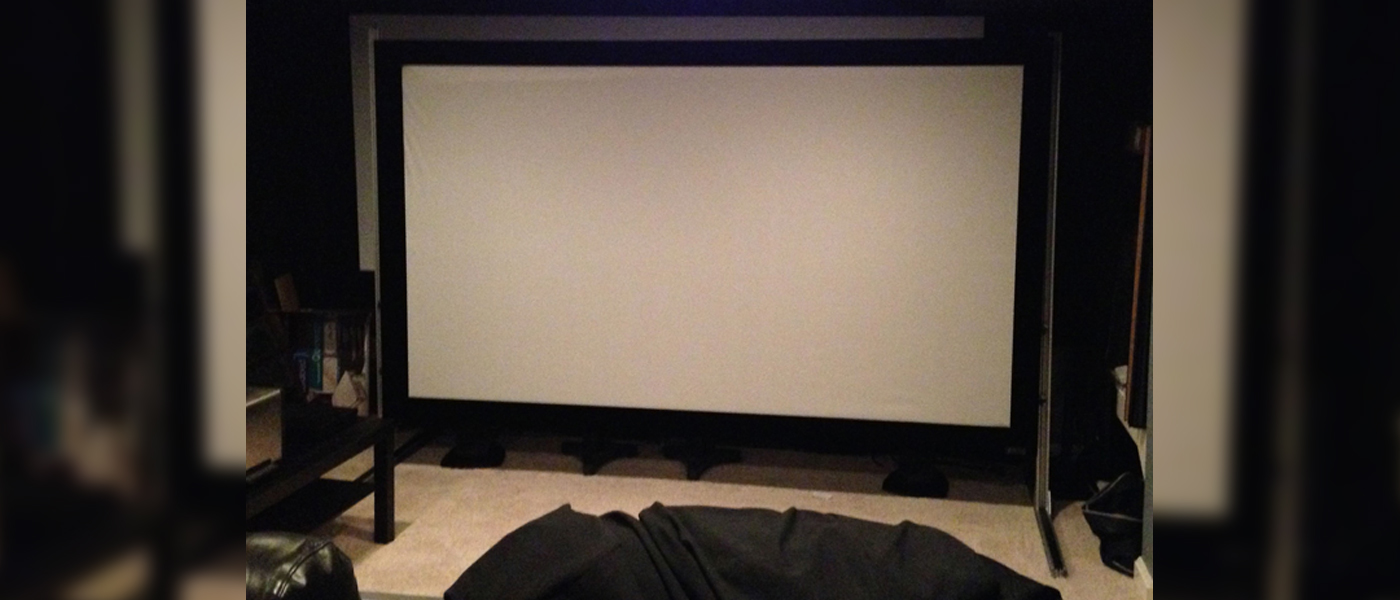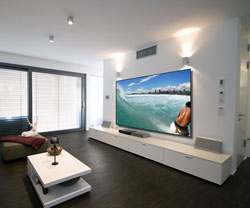Introduction to the Screen Innovations Black Diamond Zero Edge Projection Screen
When designing a home theater, the screen is often the last consideration in the plan. After all, it’s much more interesting to research electronics and their associated specs than to look through screen material samples and frame designs. Other than size, few of us think much about our choice of screen. And what about aesthetics? Many theater designs hide the screen behind curtains so it isn’t even seen until movie time. And then there’s the lighting. Not everyone wants to watch movies in total darkness. And if you want to have a few friends over to watch sports, you’ll most likely want the lights on.
SCREEN INNOVATIONS BLACK DIAMOND ZERO EDGE PROJECTION SCREEN SPECIFICATIONS
- Design: Front Projection Screen
- Available Gains: 0.8, 1.4. 2.7
- Available Sizes: Custom Sizes and Aspect Ratios up to 144” Diagonal, 2.35:1
- As tested: Gain 1.4, 80″ W x 45″ H (92″ Diagonal)
- Half-Gain Angle: 550
- Mounting System: Tongue-in-Groove (wall bracket included), 1.5” Stand-off
- MSRP: $3,099 USD (92” Diagonal Size)
- Screen Innovations
- SECRETS Tags: Projection Screens, Screen Innovations, Front Projectors, Projectors
Enter Screen Innovations. SI has always been a company that pushes the envelope with projection screen technology. Their Black Diamond material helped put them on the map by making it possible to use a front projector with the lights on. Now with the Zero Edge, they’ve created a screen that actually looks great too. Whether in use or not, the Zero Edge is a guaranteed conversation piece and will make any media room look expensive and high-end.
Two years ago, I reviewed a Black Diamond screen and found it very impressive in the area of contrast and image quality with some ambient light. SI is constantly striving to improve their products so I was quite happy to check out their latest effort with the Zero Edge. It also gave me a chance to sample my first rigid one-piece design. Let’s break the packing straps and see what we have!
Design and Setup of the Screen Innovations Black Diamond Zero Edge Projection Screen
After arranging this review with Screen Innovations, the first question they asked me was, can you get this screen in your front door? This is not a trivial issue because the Zero Edge is a one-piece panel that does not come apart. I requested a 92-inch diagonal model which matches the size of my reference Carada. Fortunately, I was able to maneuver the enormous box up to my second-floor theater. It’s not terribly heavy, just awkward.
The packaging is quite substantial and gives no indication that the screen would arrive in anything but perfect condition. The entire thing is a rigid panel, about a half-inch thick, with the screen material permanently bonded to it. The bezel is a mere quarter-inch wide and consists of a wraparound piece of black crinkle finished metal. On the back is an aluminum bracket, permanently glued on, which is channeled for easy mounting. In fact, it hung right on my existing wall bracket. One caveat – the channel is about a third of the way below the screen’s top edge. That means you’ll have to lower your mounting point, about 15 inches in my case, to place the screen at the same height.
Once hung, the screen sits off the wall about 1½ inches which makes it look like a giant, high-end flat panel. This combined with the slim bezel makes a very striking statement. The silver color of the screen material only adds to the sexiness of this product. It certainly redefines the projection screen as I know it, at least aesthetically. Another mounting option offered by SI is to hang the screen from the ceiling. This is undoubtedly the reason for the placement of the rear mounting point. That way, it will be perfectly vertical when suspended from cables (see below). To this end, SI can provide some nice machined cable anchors for those choosing this option. If you do this, you might have to cover the back of the Zero Edge since it’s essentially unfinished. Another benefit of the wall gap is you can install lighting if you wish. SI has a slick LED system available which can be adjusted to virtually any color and brightness level. It even includes a sophisticated controller for a myriad of effects and patterns.
Of course the main reason to use this screen is Black Diamond projection surface. This material has unique reflective qualities that allow you to preserve a projected image with the lights on. It does this by focusing the image straight back to the viewer rather than scattering light around the room. This approach rejects ambient light which hits the screen from a multitude of angles. Only the light from the projector, the light that is aimed straight at the screen is reflected back to the viewer.
The Screen Innovations Black Diamond Zero Edge Projection Screen In Use
I’ll put it out there right up front – the image on the Zero Edge is stunning. The contrast performance is unmatched with any screen material I have ever seen. Granted, I’m using a projector with extremely high contrast but this screen absolutely does increase dynamic range. I was immediately captivated when I turned my projector on and could barely see a black field. My Anthem LTX-500 is dark but with a typical screen, you can tell it’s on. With the Black Diamond, I could hardly tell. It took my eyes a few seconds to adjust to the darkness before I could see that the projector was indeed functioning.
The holy grail of front projection, for me at least, is to, as closely as possible, equal the image quality of the best plasma TV. I am fortunate to see that every day when I turn on my ninth-generation Pioneer Kuro, a PRO-111FD. This latest iteration of the Black Diamond screen achieves this. I can truly say this screen looks like a high-end plasma panel. It even looks like a high-end TV when there’s no image! The rigid construction and its floating off the wall look make for a very striking appearance.

I started with two unfamiliar Blu-ray titles, Fast Five and The Rite. Fast Five is an action-packed crime caper with lots of bright saturated color and razor-sharp detail. I wondered if dark scenes would give up any detail but they did not. Remember that I did not adjust my projector in any way. Higher contrast screens like this can sometimes skew the gamma curve forcing a change but the shadow detail was well-preserved and I didn’t have to make any adjustments to enjoy all my viewing. The rich accurate color I’m accustomed to was also unaffected by the Black Diamond. Hues were even bolder and deeper thanks to the increased dynamic range.
The Rite has lots of dark content which is a challenge for just about any screen/projector combination. I had no issues with this film at any time. Watching a movie like this makes me glad to have a light-tight room. Even though the Black Diamond lets you watch with the lights on, it still works best in total darkness. The color palette of this film is more muted than Fast Five but it never looked flat. Dimensionality was preserved throughout.

Moving on to some of my display review standards, I lined up Toy Story 3, Live Free or Die Hard and I, Robot. Toy Story 3 is a great example of Pixar’s fanatical attention to textural detail; something which no other animated film-maker has yet matched. The finest detail popped right out giving the image a real 3D feel. Bright scenes, dark scenes; it didn’t matter; no elements were crushed in either the darkest shadows or the brightest highlights. And color was superb of course.
Live Free or Die Hard is one of my favorite tests of contrast performance. Several scenes early in the movie have very intricate shadow detail that only the best displays can render properly. I can say I have never seen a better presentation of this Blu-ray. Blacks were truly black yet even the most subtle elements like folds of clothing or gritty walls in a run-down apartment building looked exquisite.
My final selection, I, Robot, has always been a benchmark for me as one of the very best Blu-ray transfers ever. There are basically no flaws whatsoever in this release and it will make nearly any display look good. In the case of the Black Diamond, it looked sensational. I couldn’t help but marvel at the fantastic contrast, depth, and richness of the image. It really was a sight to behold.
Now that I’ve spent seven paragraphs extolling the wonders of this screen, I have to point out one minute flaw. The last Black Diamond screen I reviewed was in 2009 and at that time, I noticed a texture artifact that looked like fine sparkles in the center of the screen. It could be classified as a hot spot and it seemed to be more visible as the screen gain increased. Knowing that SI constantly works to improve their products, I wondered if they had reduced or eliminated this effect with their latest offering. I am happy to say it is almost gone, but not quite. In the brightest, continuous toned images, I could still see the most subtle sparkling. It’s not concentrated in any one area of the screen. It’s more of a slight texturing. This is an extremely minor criticism – you have to look pretty hard to see it and it’s only in the brightest highlights.
The Screen Innovations Black Diamond Zero Edge Projection Screen On the Bench
In measuring the Zero Edge Black Diamond I wanted to know two things – how close does it come to color neutrality and does it achieve the advertised gain. To do this, I simply measured color and grayscale from my Anthem LTX-500 and compared those numbers to the reference numbers generated by my Carada screen.
First up are the color measurements. I used my usual setup of an EyeOne Pro spectrophotometer taking reflective readings from 10 feet back. You can see the CIE and luminance charts are nearly identical. Only cyan and white dip slightly towards blue. This is similar to the last Black Diamond screen I reviewed in 2009 which was also biased toward blue but to a greater degree. Luminance is also slightly affected but not visibly so.
The grayscale charts tell the rest of the story. You can see that blue and red ride a few percent above green in the tracking graph. The Delta E numbers are high enough that the error was visible but in my viewing I didn’t find the slightly cooler color temps to be a big deal. The gamma also affected with a slightly brighter average value. Again, this will be barely visible. Still, any time you change a screen, you should re-calibrate. I would do this no matter what.
As far a screen gain, the peak white measurement of 18.03 foot-Lamberts is within a whisker of the same measurement off the Carada screen which is also rated at 1.4. This tells me that the Black Diamond 1.4 gain material has an actual gain of 1.4. Contrast performance however, is clearly superior to the white screen material used by Carada. The minimum black level was not measurable by my instruments but I could plainly see a zero-percent signal was darker on the SI screen than on the Carada.
Conclusions about the Screen Innovations Black Diamond Zero Edge Projection Screen
There is no question that SI takes the word innovation very seriously. They have created their own category of projection screen without any gimmickry or pretense. The Black Diamond Zero Edge offers seriously good performance and is easily the best-looking front projection screen I’ve seen to date. The $3099 price tag is right around similarly-sized products from other high-end manufacturers like Stewart and Da-Lite. Ease of installation can’t be beat either. You just unpack it and hang it up like a picture. The look is truly stunning and the image quality is too. Add to that the ability to turn the lights on and still enjoy the presentation and you have real winner. The SI Black Diamond Zero Edge receives my highest recommendation.








